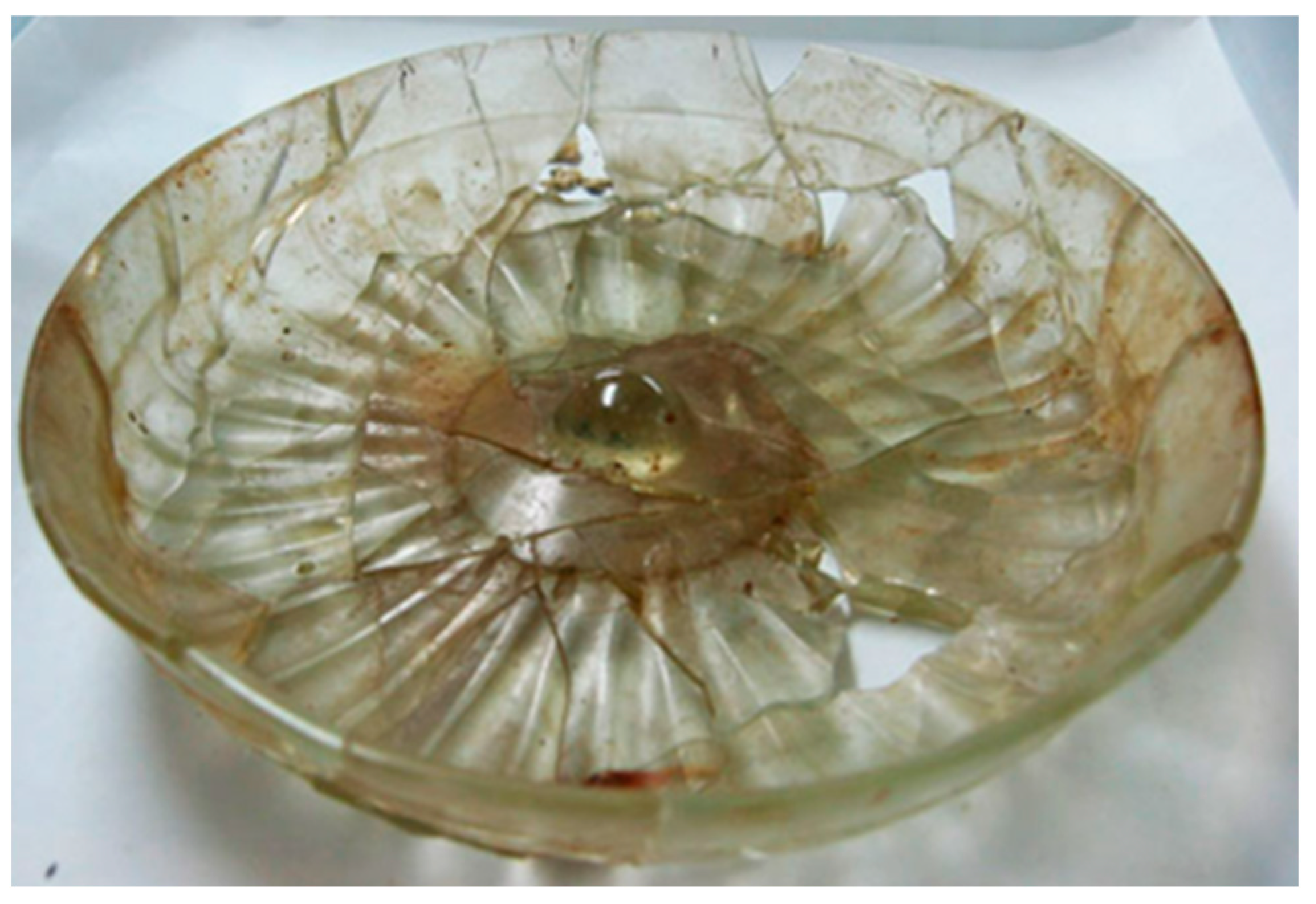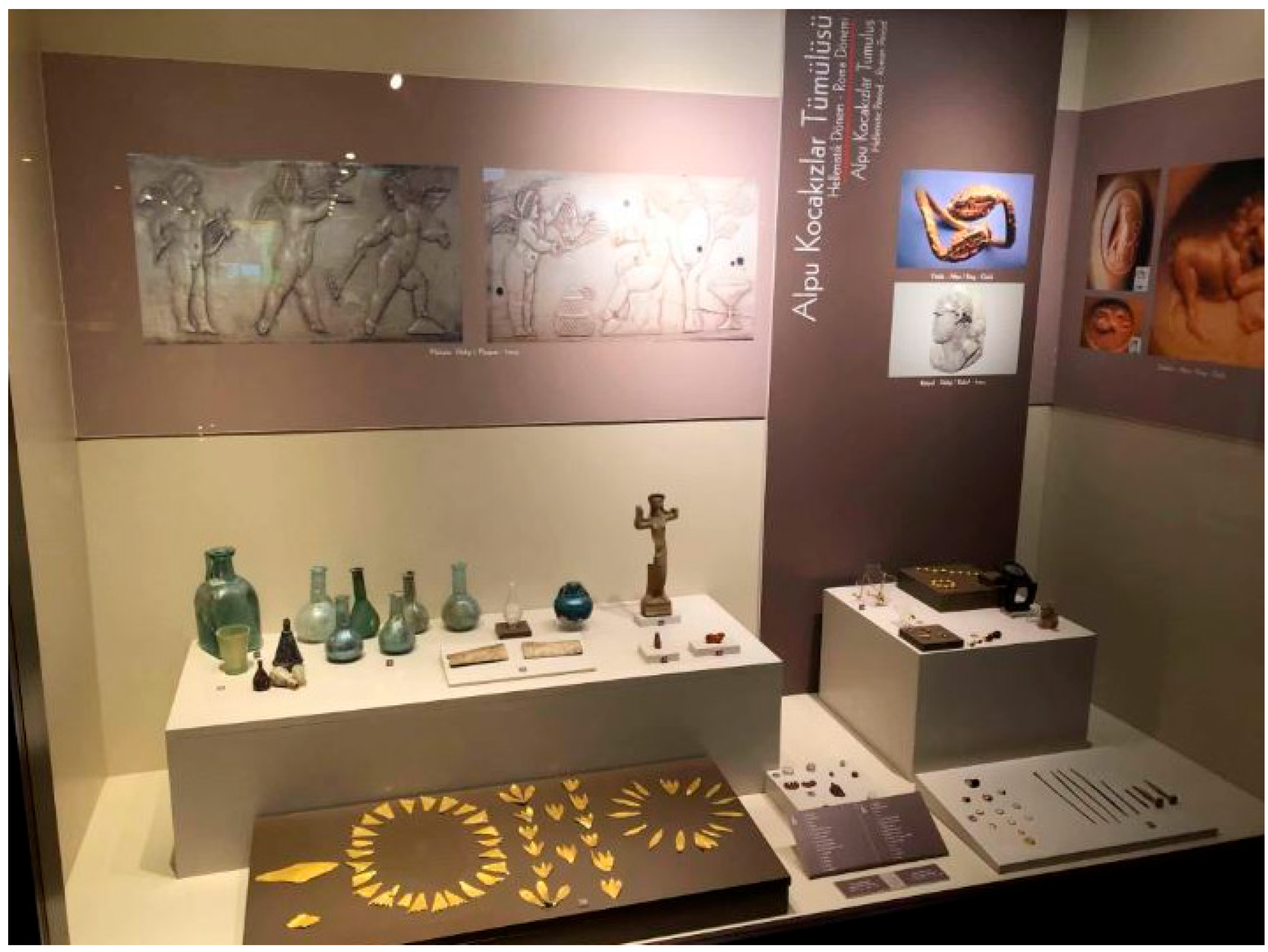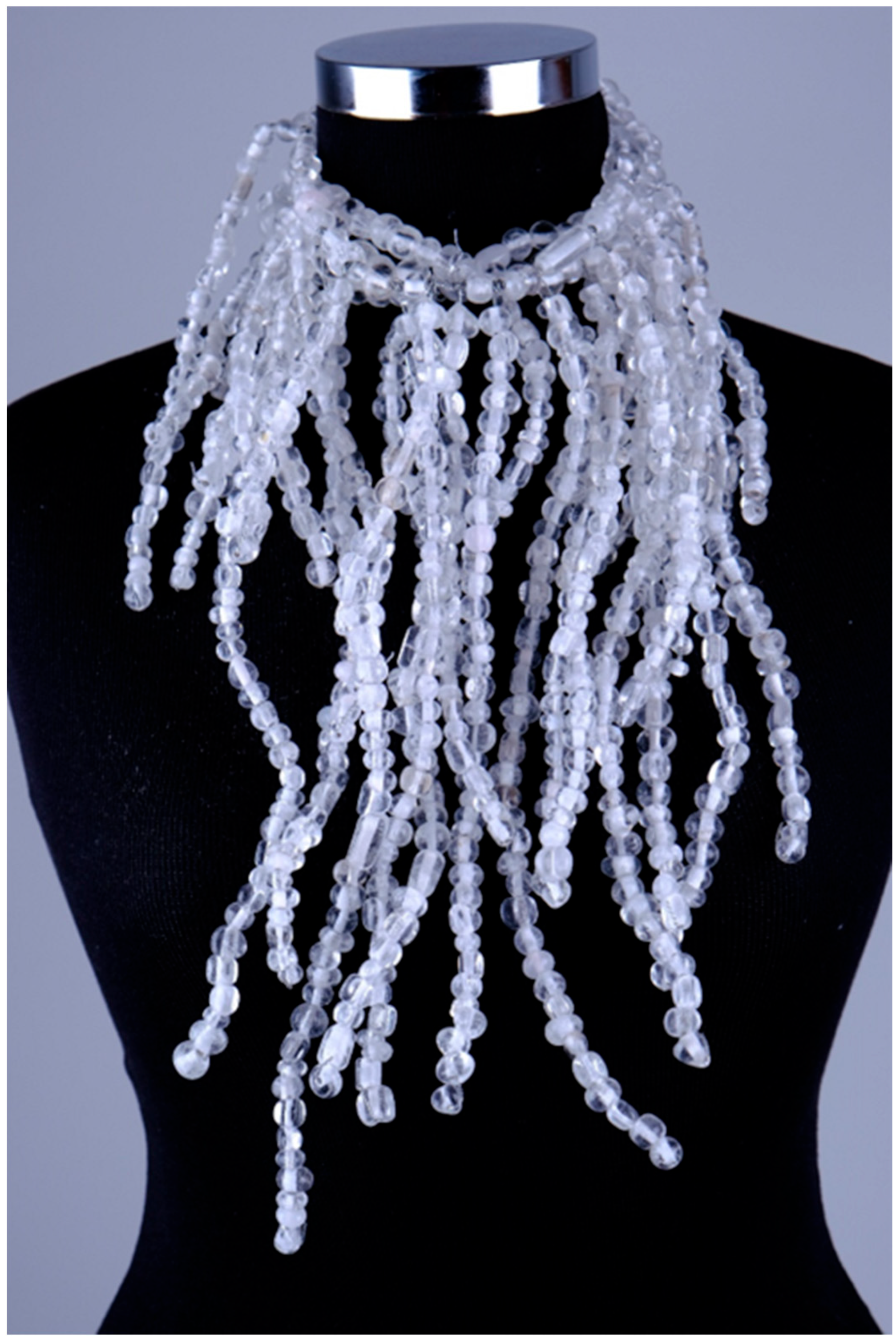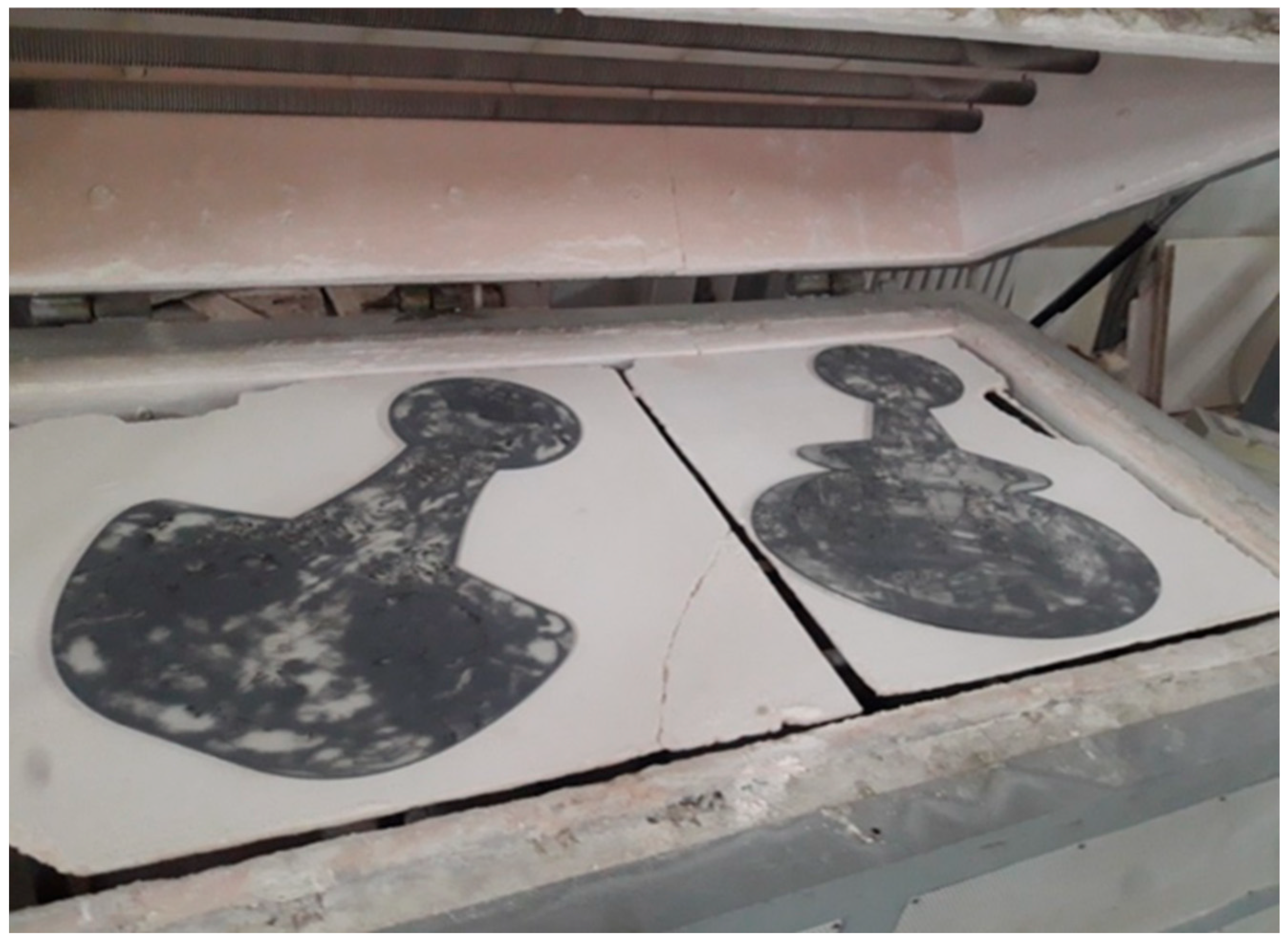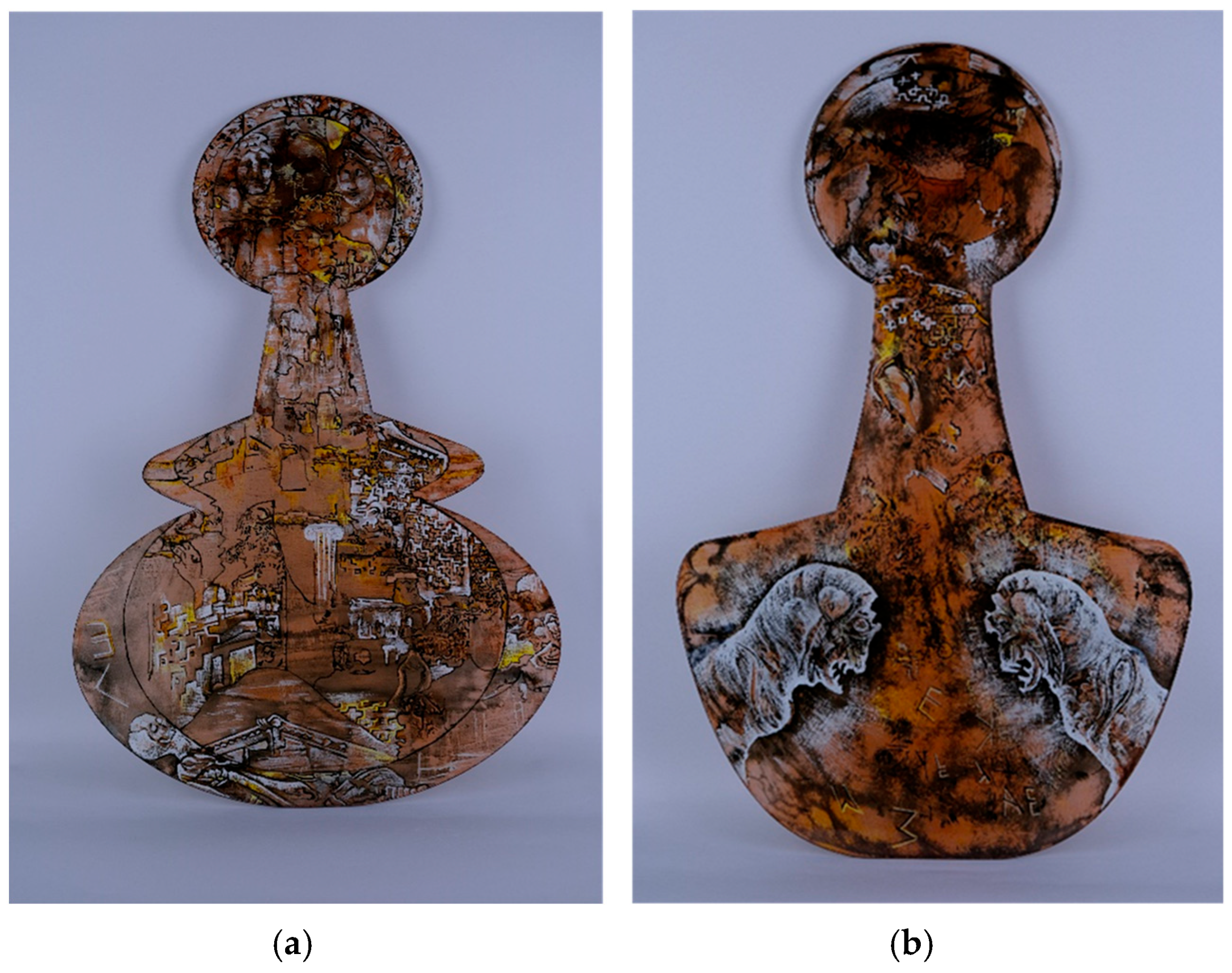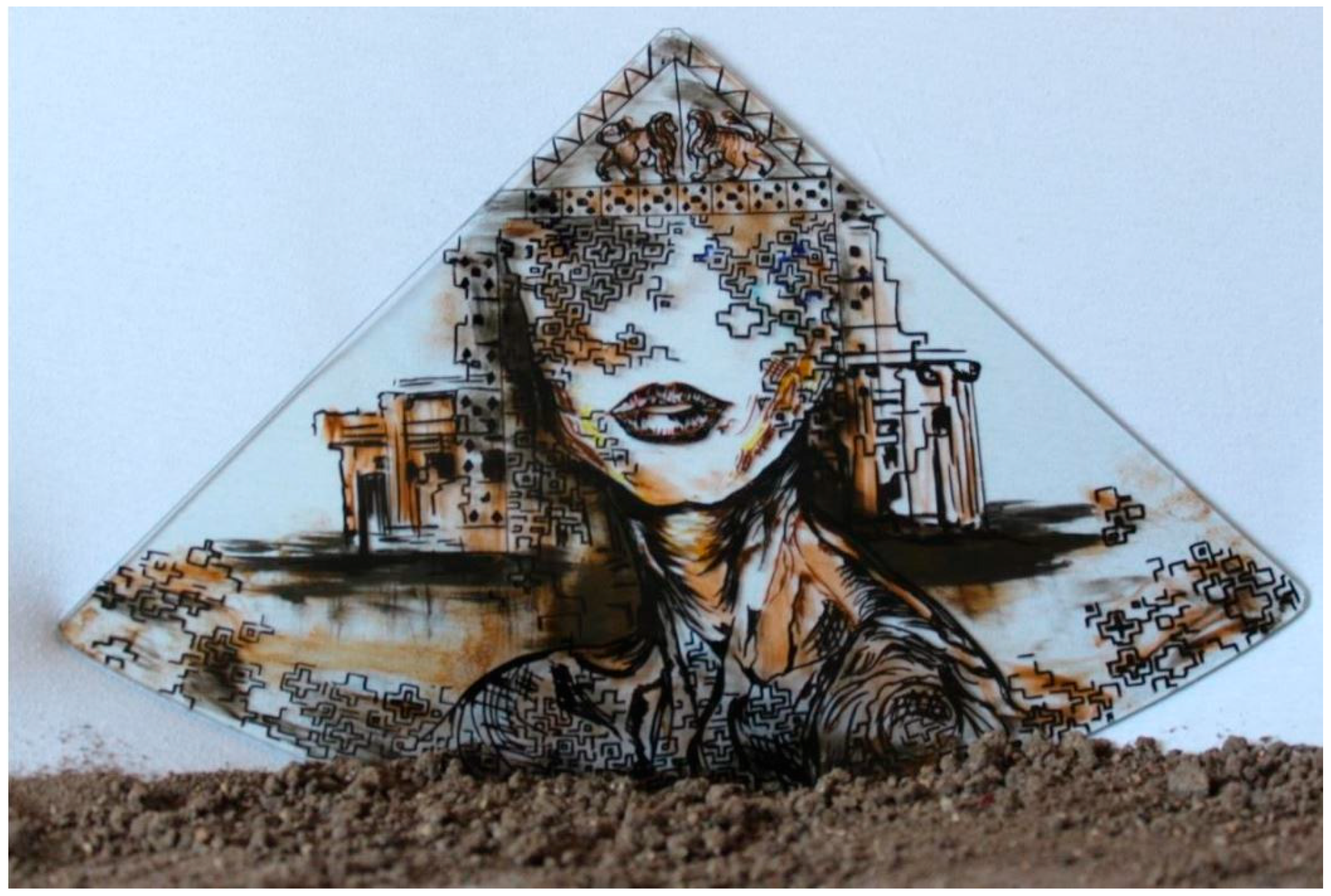1. Introduction
Glass, an amorphous solid, differs from crystalline materials due to its lack of a regular atomic structure (
Baxter 1998;
Margaret and Miller 2009). It is most commonly defined, according to the American Society for Testing and Materials (ASTM), as “an inorganic product of fusion which has cooled to a rigid condition without crystallizing” (
Bhattacharya et al. 2011;
Alzahrani 2022). Glass is essentially a supercooled liquid with high viscosity and no distinct melting point, which prevents crystallization. When heated, it softens gradually and eventually melts. Glass is formed by firing a mixture of inorganic raw materials such as silica sand, soda, lime, limestone, dolomite, and feldspar. Since ancient times, glass has been produced for both functional and decorative purposes and remains essential in fields such as construction, household goods, and telecommunications (
Angelini et al. 2019;
Margaret and Miller 2009).
Although various types of glass differ in chemical composition, they share several common characteristics. Despite its fragile reputation, glass is mechanically strong and resistant to scratches and abrasions. Chemically, it is durable, elastic, and can bend under stress, returning to its original form. Additionally, glass is thermally shock-resistant, enduring sudden temperature changes and extreme heat and cold (
web-1 2023).
Humans have always shown a deep interest in the past. The term “archaeology,” derived from the Ancient Greek words arkeo (“ancient”) and logos (“science” or “study”), translates as “the science of the past” or “the study of the ancient” (
Özbilen 2020;
Yoffee and Fowles 2011). Although the term “archaeology” was coined in the 17th century (
Bahn 2013), archaeological practices date back to Nabonidus, the 6th-century BC king of Babylon, who is considered the earliest known archaeologist. Archaeology became a systematic field of science in the 18th century, and particularly in the 19th century, excavations revealed the cultural heritage of past civilizations, offering profound insights into prehistoric and ancient societies (
Refinrew and Bahn 2017). Beyond uncovering material remains, archaeology enables historians to analyze surviving documents and examine past cultures, lifeways, and behavioral changes over time, contributing to our understanding of cultural evolution (
Flatman 2011;
Carmichael et al. 2003).
According to Colin Renfrew and Paul Bahn, the purpose of archaeology is to understand humanity, making it a humane and compassionate discipline. Archaeology aims to investigate the interactions between humans and their environment in the past, along with their corresponding cultural changes. The primary objective of archaeologists is to anchor all remnants of the past in historical data, corroborate the written information that has reached us, and thus facilitate the comprehension of history. Our understanding of the past relies on archaeologists, who use a wide range of scientific methods to ensure accurate information transfer (
Rajesh 2014). Most notably, they rely on precise dating techniques to measure time (
Gamble 2007).
Today, archaeology is a broad interdisciplinary field that spans the social sciences and humanities. While it is considered a subfield of anthropology in the United States, in Europe it is treated either as an independent discipline or as a subfield of other disciplines (
Arslan 1991). Archaeology naturally intersects with numerous fields such as history, art history, classics, philosophy, ethnology, geography, literary history, paleography, linguistics, semiotics, geological physics, information sciences, chemistry, statistics, paleoecology, paleontology, paleozoology, and paleobotany (
Karali et al. 2019). Additionally, scientific disciplines like archaeometry, physics, chemistry, botany, biology, zoology, genetics, anthropology, medicine, and astronomy contribute to archaeological research. In recent years, new sub-disciplines such as maritime archaeology, feminist archaeology, archaeoastronomy, and psychoarchaeology -which explores the emotions and thoughts of individuals who created artifacts-have also emerged (
Refinrew and Bahn 2017;
Karali et al. 2019). Alongside these developments, various scientific techniques continue to enhance archaeological investigations and discoveries.
Presently, the foundation of knowledge concerning the ancient world is predominantly built upon the robust evidence provided by archaeology (
Sevin 1999). The form of the first glass objects was quite simple, and attempts were made to imitate naturally occurring glass. The greatest leap in glass production occurred during the Roman Empire (
Stern 1999). The discovery of glass artifacts from the Roman and Byzantine periods has revealed the place of glass in material culture and how it evolved throughout his-tory. Archaeological findings have shown that glass was not only a functional material but also carried strong symbolic meaning. For example, the color, form, and pattern on glass from the Roman and Byzantine periods became symbols laden with meaning for artists (
Harden 1986). The colors, patterns, and forms of ancient glass objects have directly influenced the creative processes of contemporary glass artists. The vibrant colors and sophisticated patterns of Roman glass have left an important aesthetic legacy for modern glass art (
Harden 1986).
In a shared realm where art and craftsmanship intersect, ancient glass artisans skillfully combined their perspective on beauty and aesthetics with masterful techniques. For over three thousand years, glass producers in the ancient Mediterranean region have created striking vessels through various production techniques and decorative methods (
McClung Museum 2014).
From ancient times to the Middle Ages, numerous archaeological glass artifacts remained buried underground for years, undergoing decomposition that resulted in the formation of iridescent effects resembling rainbows on their surfaces. These effects have not only captured the interest of scholars but have also intrigued collectors and the public (
Bellendorf et al. 2010).
This study examines how archaeological artifacts from the Phrygian Valley and Phrygian culture inspire contemporary glass art, focusing on the reinterpretation of ancient cultural symbols through modern glass techniques. Seeking to answer how historical artifacts can be transformed into contemporary artistic expressions, the study aims to contribute to the dialogue between archaeology and contemporary art, offering new perspectives on cultural heritage and artistic creativity.
2. Archaeological Glass
The term “ancient glass” refers to the glass produced before the mid-17th century, a period when a rational understanding of glass composition was lacking. Ancient glass was produced through trial and error. By experimenting with available materials, glassmakers identified suitable raw materials and discovered how different substances affected glass composition (
Fernández 2009).
In ancient Egypt, another significant civilization of the 3rd millennium BC, fewer quantities of glass artifacts have been discovered compared to Mesopotamia. Most likely, the Egyptians learned the art of glassmaking from their Asian neighbors, particularly from the captives taken during Pharaoh Thutmose III’s military campaigns in the East, which took place around 1490–1436 BC. The introduction of glass technology to Egypt is also attributed to the use of glass objects and ingots as tribute during that time and the import of glasswork by Mesopotamian glassmakers around 1480 BC. Once the glass industry was introduced to Egypt, it quickly flourished due to the abundance of necessary raw materials for production. Egyptian workshops not only produced various goods to be consumed by the royal court and aristocrats capable of affording such luxuries but also exported substantial quantities of raw glass (
Salama 2019,
Erten 2004). Glass spread from these centers along trade routes, and the journey of glass has revealed to us the diverse international relationships and the areas in which trade occurred among different nations (
Eisen 1919).
Glass production quickly became a significant industry and spread to the Medi-terranean region over the next 300 years. Glass objects from this early period (1500–800 BCE) that were produced or used in the Mediterranean region have been characterized as typical soda-lime glass with high a magnesium content (3–7%) and potassium content (1–4%), which is believed to represent the nature of glass.
After the initial developmental phase, the glass industry experienced a period of decline until a revival in production that began around 900–700 BCE in Mesopotamia. This was followed by the growth of an independent glass industry along the coasts of Syria and Palestine between 800 and 500 BCE, and a subsequent resurgence in glass pro-duction in Egypt around 500 BCE (
Rasmussen 2019).
The evolution of glass production, which began in Mesopotamia in the third millennium BCE and advanced during Egypt’s New Kingdom, has been marked by continuous innovation and experimentation (
McClung Museum 2014). Influenced by the expertise of Hellenistic glassmakers, the Roman glass industry developed into a dynamic field, introducing a variety of glass vessels and windows for the first time. Over time, it grew into an independent and innovative industry that spread the art of glassmaking to Western European settlements (
McClung Museum 2014;
Rasmussen 2019;
Antik Cam Tarihi 2023).
Following the invention of glassblowing in the 2nd and 1st centuries BCE in what is now modern-day Israel, the glass industry experienced a remarkable acceleration due to advancing technology, increased production, and lower costs as the Roman Empire expanded. Starting from the 1st century, glassmaking centers were established in Italy and other regions, particularly in places like Cologne, Germany, as well as in Britain and Gaul. These centers played a significant role in shaping the rapid growth and development of the glass industry (
McClung Museum 2014).
The relationships between the field of archaeology and the natural and physical sciences have strengthened over time, leading to collaboration in numerous research areas. Ancient glass studies also constitute a significant field exemplifying this collab-oration. Ancient glass encompasses glass artifacts and structures found in archaeological excavations. Initially, archaeologists primarily examined ancient glass objects from an aesthetic and artistic perspective. However, over time, the physical and chemical properties of the material, production techniques, sourcing of raw materials, and the technological use of glass gained importance. These objects encompass glass artifacts produced by various cultures from prehistoric periods onward. Although archaeologists initially focused on the aesthetic and artistic values of ancient glass, later research emphasized the importance of understanding its physical and chemical properties, production techniques, and raw material sources. At this juncture, natural and physical sciences entered the scene, providing archaeologists with crucial insights. Through all these efforts, not only the artistic aspect of ancient glass but also its technological, commercial, and societal dimensions have become understandable. This underscores the significance and productivity of the collaboration between archaeology and the natural and physical sciences.
3. Artifacts Found in Archaeological Excavations in the Eskişehir Region—Phrygian Valley
The region of Eskişehir (Turkey) and its surroundings, a prime example of urban-ization throughout history, has been a host to significant civilizations, particularly the Phrygian civilization (
Erdoğan 2002). According to archaeological and epigraphic find-ings, the sphere of influence of the Phrygian Kingdom extended from the central region around Ankara, with the Halys River (Kızılırmak) to the east encompassing Çorum, Tokat, and Kırşehir; to the north, Samsun; to the south, Niğde and Konya; to the southwest, Burdur and the Elmalı Plains; to the west, Eskişehir, Afyonkarahisar, and Kütahya; and even as far as the Bandırma region to the northwest. Even after the Phrygian Kingdom withdrew as a significant political power from the historical stage, the diverse influences and traces of the deep-rooted culture established by the Phrygians continued to persist throughout the culture and art of ancient Anatolia during the Classical Period (
Aslan 2021). The significant cultural heritage sites in the Phrygian Valley are concentrated in the area between the Seyitgazi and Han districts of Eskişehir province, the İhsaniye, İscehisar, and central districts of Afyonkarahisar province, and the western part of the central district of Kütahya province (
Aşilioğlu and Memlük 2010). The majority of known Phrygian settlements in the region are located on alluvial plains in the Sakarya and Porsuk river basins, consisting of settlements in the form of various-sized mounds (
Figure 2) (
Özarslan 2010).
The Phrygians had a polytheistic religion; among their most notable deities were the Sun God Sabazios and the Moon God Men. However, when Phrygians are mentioned, the goddess who comes to mind immediately is Cybele, also known as Agdistis, Matar Kubile (Great Mother), or Kubile. For the Phrygians, Cybele was a nature goddess, even the embodiment of nature itself. Cybele held a universal quality symbolizing all life and fertility within nature. Additionally, Cybele was the protector of young girls. The primary center of her worship was in Pessinus. The Phrygians embraced this goddess to such an extent that they considered their entire state and nation as belonging to Pessinus Cybele. As a result, although originally an ancient Anatolian goddess, Cybele has been recorded in history as a Phrygian deity (
Birecikli 2010). Cybele, the mother goddess of Anatolia, is associated with numerous symbols that reflect her power over nature, fertility, the underworld, and the cycle of life and death. She is often depicted holding lions, which symbolize her dominion over nature and control over wild forces (
Roller 1999). Cybele is also frequently shown holding a drum (tympanum), a ritual instrument linked to her ecstatic religious ceremonies and her mastery over the rhythmic cycles of nature (
Bruit Zaidman and Pantel 1992). The key symbolizes her authority over the underworld and her role in the cycle of life and death (
Vermaseren 1987). In connection with fertility and abundance, Cybele is sometimes depicted holding fruits (especially pomegranates) and snakes, with the latter representing rebirth and the cyclical nature of life (
Roller 1999). In some depictions, coins or an olive branch are seen in her hands, symbolizing her role as a protective goddess of peace and prosperity (
Vermaseren 1987). Finally, the phiale (libation bowl) that Cybele holds reflects ritual offerings made to her, signifying her generous and nurturing nature (
Bruit Zaidman and Pantel 1992). These symbols collectively portray Cybele’s multifaceted authority over nature, fertility, and the life-death cycle, underscoring her cultural significance.
The common features of Phrygian rock monuments during the Phrygian period are generally the richness of their decorations and ornaments, the triangular pediment introduced by architecture, and rock niches containing statues of the Mother Goddess. Notable elements include statues and reliefs of the Mother Goddess Matar Ku-bile/Cybele, depictions of the Mother Goddess accompanied by reliefs of lions, tigers, bulls, griffins, or sphinxes, as well as images of gods and goddesses. Additionally, inscriptions are frequently utilized (
Şahin 2018).
Among the Phrygian Civilization, bronze artifacts are the most preserved items in the category of jewelry and metal objects. Phrygia achieved the highest quality in the production of bronze artifacts. We see the best examples in bronze artifacts in the ancient age of the Phrygian civilization. Silver artifacts come in second place. Gold artifacts that have survived to the present day are the least found in excavations. In addition to these, iron is most commonly found among examples of jewelry such as fibulae. Apart from these, necklaces made of glass beads and necklaces made of terracotta beads have also been discovered (
Arslan 2013).
We encounter data related to glass production or usage in many settlement areas across Anatolia. Among these, unprocessed glass ingots were discovered in a tomb in Troy, dated to 1360–1320 BC, alongside ceramic and metal finds (
Taştemür 2017).
The glass artifacts found in the ancient city of Gordion, the historical capital of Phrygia, form an extensive and long-spanning collection. This remarkable collection sheds light on the commercial, technological, and cultural exchanges between the East and West during the 1st millennium BC. Some of the findings even point to a glass-working tradition in Anatolia that began in the 8th century BC and continued thereafter. One of the significant periods for glass working was the Early Middle Phrygian Iron Age. In the Gordion excavations, the bowl discovered in the Phrygia-Gordion P tumulus, dated to around 760 BC and referred to as the “Gordion bowl,” is recorded as the earliest known colorless omphalos bowl (
Figure 3) (
Gordion’da Cam İşçiliği 2024;
Taştemür 2018).
Glass art, with a history dating back to as early as 3000 BC in the Anatolian regions, has constituted an important part of Eskişehir’s cultural heritage. This ancient tradition has survived to the present day, preserving its uniqueness, which traces its roots back to the ancient Phrygians (
web-2 2023).
The archaeological artifacts excavated in Eskişehir and its surroundings are displayed at the Eti Archaeology Museum. The museum houses findings obtained from excavations conducted in various regions such as Dorylaion (Şarhöyük Eskişehir-Tepebaşı), Pessinus (Sivrihisar-Ballıhisar), Han Underground City (Han Yazılıkaya), Keçi Çayırı (Seyitgazi-Bardakçı), Çavlum Village Ancient Hittite Site (Odunpazarı-Çavlum), Demircihöyük (Çukurhisar-Tepebaşı), Karacahisar (Odunpazarı-Karacaşehir), and Küllüoba (Seyitgazi-Yenikent).
Among the artifacts obtained from excavations conducted in many different archaeological sites in the region, there are coins, jewelry, weapons, glass vessels, pottery items, marble sculptures, architectural objects, steles, idols, beads, and metal objects. In
Figure 4 and
Figure 5, archaeological artifacts consisting of perfume bottles, jugs, food containers, cups, necklaces, bracelets, etc., found in the Eskişehir Alpu Kocakızlar Tumulus, can be observed (
web-3 2023).
4. Glass as an Art Material
The artistic character of antique glass relates to form, color, and technique-elements that remain unmatched in modern times, yet could serve as valuable studies for contemporary artists before inventing new forms of their own. The softer and more harmonious colors of antique glass, compared to those employed today, have inspired numerous prominent artists, decorators, and designers (
Eisen 1919).
Throughout history, artists have used various materials for self-expression, and glass has been among the most enduring and versatile. Although it has a long and dynamic history, glass remains an ancient material with an incredibly contemporary presence. Its unique qualities allow it to transmit, absorb, and reflect light. To fully appreciate the value of glass, one must recognize that the richness of glass art is the result of centuries of historical accumulation. A careful examination of the past provides artists with insights into both the artistic and practical applications of glass, encompassing techniques and aesthetic possibilities that continue to be relevant in art, daily life, and architecture (
Naydenova 2020).
Used since ancient Mesopotamia and Egypt, glass has continuously evolved as both a functional and artistic material (
Freestone et al. 2005). Early glass production focused on small beads, ornaments, and containers (
Harden 1986;
Stern 1999). By 1500 BC, these production techniques had advanced significantly, leading to the widespread creation of decorative objects and bottles, particularly in Egypt (
Nicholson 2000;
Harden 1986).
The development of glassblowing techniques during the Roman Empire allowed for more creative manipulation of glass forms, establishing glass as a prominent mate-rial in the art world (
Tait 1991). During the Middle Ages, glass—especially stained glass—became a dominant artistic medium, with church windows serving both as artistic expressions and as symbols of religious significance (
Cennini 1933). In the Re-naissance period, glass craftsmanship flourished, particularly on the island of Murano in Venice, where innovative techniques elevated glass to an artistic pinnacle (
Toninato 2014).
Glass continues to enhance modern human life through diverse forms of artistic expression. Its light-transmitting quality makes it an attractive and luminous material. Technological advancements related to the composition of glass have further improved this characteristic. Depending on usage demands and decorative purposes, glass can be produced as non-transparent, fully transparent, or semi-transparent. Additionally, its texture can be altered based on raw material composition and production planning. Glass can be colored through various methods, with its constituents and added elements affecting color formation. Even slight changes in the glass recipe can offer a broad spectrum of color tones, providing greater opportunities for artistic creativity (
He 2016).
The history of artistic glass craftsmanship and industrial glass production is marked by challenges that have been overcome, opening new possibilities for creative expression. The experiences of industrial glass manufacturers are particularly significant for artists, as the technical knowledge gained from these environments can inspire and inform creative studio practices. As technology advances, artistic glass production faces fewer limitations, enabling greater innovation (
Bialek 2022).
Glass’s unique structure, which allows for both strength and flexibility, makes it an ideal medium for artistic creation. Unlike metals that solidify or flow at specific temperatures, glass gradually softens as temperature rises, undergoing various shaping stages until it becomes viscous and flows smoothly. As it cools, glass becomes increasingly viscous until reaching a hardened state. Each stage of this process offers opportunities for shaping glass into diverse forms using various techniques (
Hemp 1995).
For artists, glass is a challenging yet rewarding material. Every stage of the glass production process entails risks for both the artist and the artwork, but the design possibilities it offers are limitless. Although more demanding than many other materials, the creative outcomes can be remarkably profound. A glass artist must master complex technical and chemical processes and creatively apply this knowledge and skill. Due to its extraordinary and unique properties, glass provides artists with powerful opportunities for creative expression. These qualities make glass one of the most exciting materials for exploring original concepts, creativity, and communication (
Naydenova 2020).
Glass also mediates the expression of light, color, form, texture, and physical presence. As an artistic medium, glass possesses characteristics such as reflection, re-fraction, transparency, color, opacity, and surface diversity. It is highly malleable and adaptable through methods such as blowing, casting, pressing, cutting, fusing, molding, melting, and laminating. Glass can be shaped into any form and embellished with techniques like engraving, grinding, painting, sandblasting, enameling, and cutting. Its physical properties invite contemplation of paradoxes and dualities, offering artists a vast range of metaphorical possibilities. Consequently, across centuries, glass has been extensively used due to its unique and multifaceted nature (
Bialek 2022).
5. Personal Artistic Works and Method
In this study, new glass jewelry and artistic glassworks have been produced, in-spired by archaeological artifacts and findings, resulting in original works based on contemporary designs and personal interpretations. In the design process, the female figure, which references the temporal societal values and beliefs reflected in artworks, has played a central role. Particularly, the cult of the Mother Goddess in Phrygian art has provided an important reference point in this context. The designs have been grounded in the portrayal of Kybele with powerful animals and her connection to nature. Throughout these endeavors, the concept of femininity, encompassing enduring fundamental notions, has been expressed through the association of strength, transparency, and fragility with glass, drawing inspiration from the Kybele.
In ancient times, beads, necklaces, and bracelets were widely used among women, primarily for symbolic or spiritual support. The styles of jewelry used in each era reflected the zeitgeist of their time. In this study, glass jewelry designs were created by shaping transparent glass beads using the flameworking technique. The production processes involved successful utilization of techniques such as stained glass, flame-working, and glass painting.
5.1. Artworks Produced Using the Flameworking Technique
First, glass bead production and design were carried out using the flameworking technique. The earliest known glass or glazed beads were produced in Egypt before 3000 B.C. (
Saitowitz 1990). Each glass bead possesses its unique value, with many harboring intriguing stories and meanings. These beads serve as not only artifacts created by their makers but also as objects employed by users to express their lives and experiences. Furthermore, these beads have functioned as a visual means of communication, often serving as a cultural communication tool, used to convey various thoughts and beliefs (
Özek 2017).
The flameworking technique involves the process where glass (
Figure 6), softened by the heat of the flame, is molded into desired forms using different shaping tools (
Buljević and Antonaras 2012).
In the production process, molten glass was wrapped around a metal rod to create spherical bead forms. A total of 785 glass beads were produced and shaped in an open flame at 850 °C, and they were then assembled to create a large-scale necklace design (
Figure 7).
The design from the “Korunma (Protection)” series is presented in
Figure 8.
The Phrygian period was a rich era in antiquity when symbols expressed through ornaments such as beads, necklaces, earrings, and bracelets held great significance. These adornments were not only representations of hope for Phrygian women but were also seen as powerful symbols of the natural world. Moreover, they were used for protection against the evil eye, to ward off negative energies, and to ensure personal safety. These pieces of jewelry may also have served mystical and spiritual purposes, such as magic, amulets, and protection from the evil eye (
Arslan 2013).
Furthermore, these jewelry pieces may have served as a means for the Phrygians to express their inner world and personal identities. In this context, the “Protection” series of glass jewelry has been designed with the aim of bringing the symbolism of the Phrygian period into the modern age. These pieces emerged as an endeavor to reflect the symbolic meanings carried by ancient glass beads and jewelry. These artworks have been produced using the flameworking technique and presented in
Figure 9.
5.2. Artistic Glass Produced with Stained Glass Technique
As part of the research, designs inspired by archaeological findings were created using the stained-glass technique. Stained glass, considered an art of embellishing or painting glass, is regarded as a means of transforming light into a play of colors and images (
Altet 2007).
This stained-glass work created using the stained-glass technique, underwent a three-stage painting process and was fired to ensure the adhesion of the stained-glass paint to the glass surface. In the first stage, black paint was used to outline the main features. Subsequently, in the other two stages, coloring was applied. During these stages, the application of colors to the glass initiated the play of colors and images that forms the essence of the stained-glass technique. This approach enhanced the visual appeal and symbolism of the work. The figures on the work, which had been fired and painted three times, were emphasized in a linear style by etching with a dremel (
Figure 10). This technique rendered the figures more distinct and provided visual depth. The firing regimen is a critical factor that ensured the successful completion of this process, and its details are presented in
Table 1. The use of these methods has made it possible to transfer symbolic meanings from ancient artifacts to modern designs, allowing glass to undergo a vivid and striking transformation through the aesthetic and artistic potential of the stained-glass technique.
These designs symbolize women’s resilience by connecting their strength to the durability and elegance of glass, highlighting both the artistic and cultural significance of the material. While glass may appear fragile from the outside, it is, in fact, a tough and resilient material. Similarly, women, when viewed externally, may seem fragile, yet they possess an inner strength. In the works inspired by Kybele, the depth and transparency of a woman’s inner world are symbolically expressed. These designs aim to highlight a woman’s inner strength and freedom. The transparent nature of glass is associated with a woman’s emotional and intellectual openness, reflecting the clear expression of her inner thoughts and emotions. However, these designs also reflect a woman’s vulnerability. The fact that glass can break symbolizes a woman’s sensitivity to the challenges of life and her emotional aspect. When a woman’s vulnerability is combined with inner strength and resilience, it creates a greater sense of unity and human understanding.
Glass artworks produced using the stained-glass technique are presented in
Figure 11.
5.3. Artistic Glass Produced with Painting Technique
In this technique, after creating the design, the artist applies it to the glass surface using permanent glass paints and then heat treats it at a certain temperature to stabilize the glass. The advantage of this technique is that the glass gives the painting a long service life and a constant shine (
Eskişehir City Center 2023).
In the first step during the application, outlines are drawn on the glass surface using black glass paint and the glass is kept in the kiln for 20 min at 250 °C for stabilization. In the second stage, the coloring process is carried out and the glass is kept at 250 °C for a while again (
Figure 12 and
Figure 13) (
Carboni and Whitehouse 2001).
6. Discussion
The findings of this study highlight the profound relationship between archaeology and contemporary glass art, offering valuable insights into how historical artifacts and cultural symbols can be transformed into modern artistic expressions. By engaging with archaeological discoveries from the Phrygian Valley, the study demonstrates that contemporary glass art can serve as a dynamic medium for reinterpreting and pre-serving cultural heritage, thereby establishing a meaningful dialogue between the past and present.
First, this research shows that glass art is not only a material practice but also a carrier of cultural narratives and historical memory. The reinterpretation of ancient motifs—such as representations of Cybele, nature symbols, and jewelry pat-terns—through modern glass techniques illustrates the capacity of glass art to convey complex symbolic meanings rooted in ancient cultures. By utilizing materials such as glass, which itself has a long historical trajectory, artists can connect with ancient traditions while simultaneously generating innovative and contemporary artworks. This process not only sustains the relevance of archaeological heritage but also expands the expressive boundaries of glass art as a field.
Second, the study contributes to the field of archaeology by offering an artistic perspective that moves beyond conventional academic analysis. Rather than limiting archaeological artifacts to static museum displays or textual descriptions, this research emphasizes their potential to inspire living artistic practices, fostering new ways of engaging with and interpreting the past. In doing so, it aligns with broader interdisciplinary approaches in archaeology that seek to reintegrate material culture into con-temporary life, making the past accessible and meaningful to modern audiences.
Third, from a design and artistic research perspective, the study provides a unique model for practice-based inquiry, demonstrating how artists can engage with historical and cultural sources to develop new design languages. By focusing on the symbolic and aesthetic dimensions of ancient artifacts, the research suggests pathways for designers to create works that are both visually compelling and culturally resonant. The exploration of female power, nature, and mythological themes through glass art also opens up opportunities for social commentary and contemporary relevance, positioning design as a medium for cultural reflection and transformation.
Furthermore, the integration of archaeological heritage into contemporary glass art reflects broader trends in cultural heritage-based creative industries, where traditional knowledge and cultural history serve as resources for innovation. This approach resonates with the growing emphasis on sustainability and cultural continuity in contemporary design, as artists and designers seek to create works that respect and revive historical legacies while responding to present-day aesthetic and conceptual challenges.
In sum, this study underscores the multifaceted role of glass art as both an artistic practice and a medium for cultural storytelling, demonstrating that historical and archaeological materials can inspire new creative directions that bridge past and present, tradition and innovation. It highlights the value of interdisciplinary collaboration be-tween art, archaeology, and design, encouraging future research and artistic practices that further explore this fertile intersection.
7. Conclusions
This study makes significant contributions to the fields of art and culture by demonstrating how archaeological findings can inspire contemporary glass art. Through an analysis of the aesthetic, symbolic, and cultural values of artifacts from the Phrygian Valley, the research reveals how these ancient elements can be reinterpreted and transformed into modern artistic expressions through glass art.
One of the key findings of this study is that symbols from antiquity-such as the figure of Cybele and Phrygian jewelry motifs—can be integrated into contemporary artistic creation, thereby revitalizing cultural heritage through modern glass techniques. In particular, glass designs shaped around the female figure embody universal themes such as female strength, nature, and the cycle of life, assigning new meanings to ancient symbols.
Moreover, the study offers a practical model for establishing dialogue between archaeology and contemporary art. The original glass designs inspired by archaeological artifacts exemplify how practice-based research can contribute to both academic knowledge and creative processes in art and design. This interdisciplinary approach highlights the role of glass art as a bridge between past and present, connecting historical symbols to contemporary aesthetic and conceptual frameworks.
Additionally, the research demonstrates how traditional archaeological forms and symbols can be transformed through modern glass techniques, showing how aesthetic connections between ancient and contemporary art can be forged. These findings provide a new perspective on how archaeological heritage can be reinterpreted and communicated through contemporary artistic languages, emphasizing that glass art is a powerful medium for transmitting cultural memory.
In conclusion, this study underscores that glass art is not merely an aesthetic practice but also a medium for expressing profound cultural and societal meanings. It highlights the transformative potential of bringing archaeological findings into contemporary artistic creation, offering both artists and audiences a meaningful and reflective engagement with cultural heritage.


